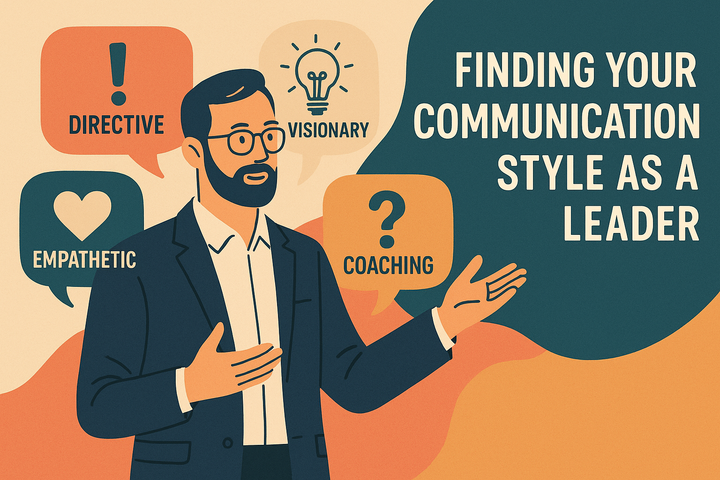The Advanced Art of Saying Less but Landing More
Master the art of concise communication to enhance leadership, foster trust, and drive action through clear messaging and active listening.

Effective communication isn’t about saying more - it’s about saying what matters. Leaders who master concise messaging save time, avoid confusion, and build trust. Here’s how you can start:
- Simplify your ideas: Break down complex concepts into clear, actionable points.
- Use silence wisely: Pausing can encourage deeper thinking and better responses.
- Tell focused stories: Stick to one key message to inspire action.
- Listen more: Active listening builds trust and uncovers insights.
Quick Tips for Clear Communication
- Start with the main point: Use methods like BLUF (Bottom Line Up Front).
- Focus on one idea: Avoid overwhelming your audience with too much information.
- Edit ruthlessly: Remove unnecessary words to sharpen your message.
- Time your words: Know when to stop talking or let silence do the work.
"Perfection is achieved, not when there is nothing more to add, but when there is nothing left to take away." – Antoine de Saint-Exupéry
Ready to make every word count? Let’s dive into the details.
How to Be CLEAR and CONCISE When You Speak as a Leader
Getting to the Point
Clear communication is about delivering the right message effectively. Leaders who excel at concise messaging enable quicker decisions and improved outcomes.
Clear Messages in Action
The military's Bottom Line Up Front (BLUF) method offers a straightforward way to communicate with precision. It’s designed to cut decision time and improve accuracy by focusing on three key elements:
| Element | Purpose | Example Structure |
|---|---|---|
| Situation | Establish the context | "We're facing X challenge..." |
| Complication | Emphasise the urgency | "This impacts Y by..." |
| Solution | Propose a clear action | "We need to implement Z..." |
A real-world example of BLUF in action occurred in 2020. Captain Brett Crozier of the USS Theodore Roosevelt used this method during a COVID-19 outbreak. He opened his message with: "Decisive action is required now...and therefore cannot allow a single Sailor to perish as a result of this pandemic unnecessarily". This direct approach spurred an immediate response. Once your message is clear, focus on presenting one idea at a time to keep your audience aligned.
One Message at a Time
Powerful communication sticks to a single idea. Complex or unclear messages can lead to costly mistakes. For instance, password retrieval issues alone cost organisations £5.8 million annually.
To stay focused:
- Identify your main point: Decide on the one key takeaway for your audience.
- Condense it into one sentence: If you can’t, you may be trying to say too much.
- Be assertive: Communicate your position clearly and memorably.
After establishing focus, refine your message further by using fewer words.
Leading with Fewer Words
The TOWER method is a simple framework to ensure clarity in your communication:
| Step | Action | Purpose |
|---|---|---|
| Think | Identify your core message | Define your main goal |
| Organise | Structure your key points | Create a logical flow |
| Write | Draft concisely | Get your ideas down |
| Edit | Remove unnecessary details | Sharpen the message |
| Rewrite | Refine for impact | Ensure maximum clarity |
"Good communication is the ability to say the most stuff in the fewest words." - Mark Twain
Listen More, Speak Less
Leadership isn't about dominating conversations; it's about fostering understanding. In the UK, only a quarter of employees trust their leadership, showing that listening effectively can make a real difference.
Why Listening Makes Better Leaders
When leaders actively listen and follow through, employees are twice as likely to feel that their opinions matter. Trust grows when people feel heard.
Here’s a breakdown of listening levels and their effects:
| Listening Level | Action | Impact |
|---|---|---|
| Surface | Paying basic attention | Basic understanding |
| Active | Truly focusing | Better comprehension |
| Deep | Being fully present | Builds trust and sparks ideas |
| Strategic | Using silence purposefully | Leads to valuable insights |
Stop, Ask, Confirm
The SAC method ensures leaders get the most out of conversations:
- Stop: Eliminate distractions, make eye contact, and use open body language to show you're fully present.
- Ask: Use open-ended 'what' and 'how' questions to uncover deeper perspectives.
- Confirm: Repeat or summarise what you've heard to ensure clarity and understanding.
The Strength of Silence
Silence can be a powerful tool. Jessica Deckinger, Chief Communications Officer at Everbridge, highlights the value of "setting boundaries around those intentional moments where you set aside half an hour every day to connect on a human level with someone".
Here’s how to use silence effectively:
| Moment | Purpose | Outcome |
|---|---|---|
| After Questions | Give people time to think | Encourages deeper responses |
| During Tension | Defuse emotions | Leads to better solutions |
| Before Decisions | Allow reflection | Results in smarter choices |
"People don't care how much you know until they know how much you care." - Theodore Roosevelt
Leaders who embrace silence often uncover insights that endless talking can miss. Next, discover how concise, powerful storytelling can amplify your leadership skills.
Short Stories That Work
Stories drive action when they stay focused. A well-told, concise story can shift perspectives much quicker than drawn-out explanations.
Keep Stories Simple
Simplicity makes stories stick. The most memorable ones follow a clear path without unnecessary details. Here's how simplicity compares to complexity:
| Approach | Example | Impact |
|---|---|---|
| Complex | Overloaded with background, multiple characters, and side plots | Weakens the main message |
| Simple | One character, clear challenge, direct outcome | Easy to remember and act on |
| Focused | Includes only relevant details with a clear purpose | Inspires action effectively |
Now let’s look at the key elements that transform a straightforward story into something powerful.
Context, Change, Call
Every effective story includes three core ingredients to inspire action:
-
Set the Scene
Start by establishing the context. Show what’s at stake and introduce the people involved. -
Show the Shift
Highlight the turning point or moment of change. This creates tension and grabs attention. -
Make the Ask
Conclude with a clear, actionable takeaway that resonates with your audience.
Making Stories Count
The best stories show rather than tell. Instead of simply stating someone’s strengths, illustrate them through specific actions:
| Telling | Showing |
|---|---|
| "Rosie is incredibly dedicated to her clients. She always goes above and beyond, bringing in more business for the firm." | "One hectic morning, a client came to Rosie, overwhelmed by his tax return. She spent two hours walking him through it step by step. A year later, he moved all his business to our firm." |
| "Leadership is about inspiring others by example." | "When Jane said her team could beat their quarterly goal, I was sceptical - it was the toughest target we’d ever set. But they devised a smart way to share the workload and smashed it with 125% of the goal. I’m a believer now!" |
"Specificity is credibility!" - Patrick Thomas
Use short, impactful stories in key moments like:
- Launching new projects
- Celebrating team achievements
- Simplifying complex changes
- Building trust in decisions
In the next section, we’ll dive into how timing plays a crucial role in using these concise stories effectively.
When to Say Less
Knowing when to hold back can make a big difference in your effectiveness as a leader. Sometimes, silence or fewer words can have a stronger impact than speaking endlessly.
Too Much vs Just Enough
Success in communication isn’t about saying more; it’s about saying what matters. While engaged teams are more productive, too much information can overwhelm them. Striking the right balance is key.
| Communication Style | Effect on Teams | Business Results |
|---|---|---|
| Too Much | Overwhelms, reduces focus | Lower productivity, missed opportunities |
| Balanced | Keeps engagement, ensures clarity | Better retention, faster execution |
| Minimal | Promotes focus, invites input | More dialogue, improved solutions |
Here’s an example: During a client meeting where progress had stalled, Tim Denning used one concise statement to change the tone completely. He said, "Gentlemen, 2000 leads a month is utterly unfeasible. We must commit to honest dialogue if we're to move forward". That directness shifted the entire discussion.
Recognising the right moments to pause or stop talking can help maintain focus and drive better outcomes.
Signs to Stop Talking
To use the power of fewer words effectively, watch for these moments to step back:
-
Audience Disengagement
If people start checking their phones or seem distracted, it’s a clear cue to wrap things up. -
Repeating Yourself
When you notice you’re saying the same thing multiple times, it’s time to stop. As Christy Wyatt, CEO of Absolute Software, explains, "People read a lot more meaning into things that you didn't necessarily intend to have meaning. People will make up stories in the white space". -
Conversations Losing Momentum
If the room goes quiet, don’t feel the need to fill the silence. Pausing can encourage reflection and invite others to contribute.
Writing down key points instead of repeating them verbally can also help. This technique leads to clearer communication, shorter meetings, better team independence, and smoother collaboration.
Conclusion: The Impact of Fewer Words
Clear messaging, active listening, and focused storytelling can transform how leaders communicate.
Using concise language increases influence and delivers results by cutting through unnecessary clutter.
Main Point
As discussed earlier, using precise language leads to decisive actions. Studies reveal that effective communication improves retention by 50% and enhances team performance.
"The best leaders are able to help people see the future and make that future concrete." - Kristen Getchell, Associate Professor of Business Communications at Babson College
Next Step
Put these three steps into practice for immediate results:
- Summarise your message in three sentences or fewer.
- Leave room for feedback and input.
- Use clear, straightforward language to build trust.
"By being concise and to the point, you not only ensure that what you're contributing is of value, and delivered with maximum impact, but you also demonstrate to those around you that you respect them and their time"
Striking the right balance between too little and too much fosters meaningful conversations.
FAQs
How can I use the BLUF method to communicate more effectively in business?
The BLUF (Bottom Line Up Front) method is all about starting with your main point first, then adding context and details. This approach ensures your message is clear and saves time for busy readers.
To use BLUF effectively, focus on three key steps:
- Know your audience: Tailor your message to what they need to know.
- Identify your main point: Be clear on the most important takeaway.
- Keep it concise: Avoid unnecessary details and stick to what matters.
This method is particularly useful in fast-paced business environments where clarity and brevity are valued.
How can I effectively use the TOWER method in my writing?
The TOWER method can help you streamline your writing process and ensure your message lands with impact. To incorporate it effectively, start by thinking through your key message - what’s the one point you want your audience to take away? Next, organise your ideas logically, focusing on clarity and flow. Then, write with precision, using concise language and avoiding unnecessary fluff. Finally, edit ruthlessly - cut anything that doesn’t serve your main point and polish for readability. Repeat this process until your message is sharp and compelling.
How can I improve my active listening to build trust and collaboration within my team?
Active listening is about fully focusing on the speaker, understanding their message, and responding thoughtfully. When done well, it strengthens trust and fosters collaboration.
To practise active listening:
- Eliminate distractions and give your full attention to the speaker.
- Paraphrase or summarise key points to show understanding and ensure clarity.
- Ask open-ended questions to encourage deeper discussions.
- Avoid interrupting and let the speaker finish their thoughts before responding.
- Use non-verbal cues like eye contact and nodding to show engagement.
By listening actively, you demonstrate respect and empathy, creating an environment where team members feel heard and valued. This not only builds trust but also leads to better problem-solving and stronger team connections.



